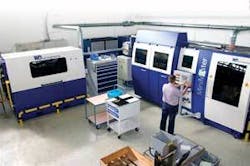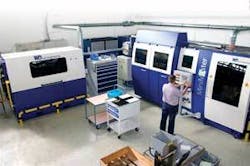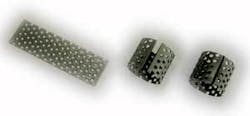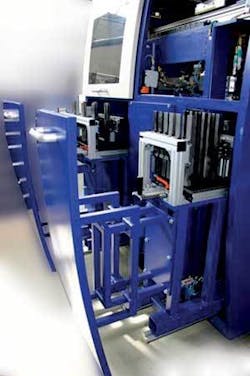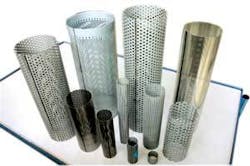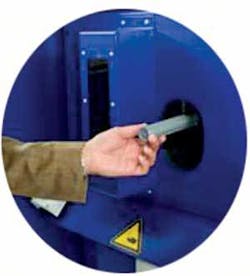Flexibly Producing Filter support tubes
Filter specialist opts for a semi-automatic production center for its tube production
Martin Stöckle
Experience and creativity associated with dedication and modern equipment summarizes the corporate philosophy of K. & H. Eppensteiner GmbH & Co. KG (Ketsch/Rhein, Germany), which develops and manufactures top-quality industrial filters and hydraulic accumulators for international distribution under the registered brand name EPE. Founded in 1926 as a metal spinning factory and toll (contract) manufacturer of sieves and similar products, it evolved into a company that today totals 230 employees with an approximate annual turnover of 25 million Euros.
Production is extremely high in the main factory in Ketsch and if necessary regional suppliers are utilized. Production is divided into two areas: the production of filters and filter elements. Approximately 500,000 filter systems are manufactured each year, with quantities varying between 1 and 2000 per batch. By combining production technology, comprehensive production machinery, and highly trained personnel, every customer demand can be fulfilled successfully and on schedule.
The main focus is on quality because only first-class filter systems and hydraulic accumulators can guarantee trouble-free machine operation. To ensure this level of quality and essential cost-effectiveness, the company places emphasis on in-house production using the latest technology and procedures. Targeted investments sustain lasting competitive strength and the company is always ready to adopt a new method. The latest example is a flexible production center for the manufacture of individual filter support tubes.
Flexible production required
Hubert Auer, managing director of Eppensteiner, says, “We have 20 product lines, with roughly three to five sizes within each line. There are also 20 different types of filter material, three different types of glue, and five different types of sealing material, so that in the end several thousand variations are possible, which still have to be manufactured economically. When it came to rationalizing and modernizing the production of customized support tubes, we looked for a highly flexible solution which was mostly automated and included welding.”
Support tubes are generally manufactured from a coil or sheet metal that is punched or perforated in-house and cut length- and widthwise into blanks. These blanks can be either of tinplate, galvanized steel, or stainless steel, which is very demanding on the joining technique. Contact was made with Weil Engineering GmbH, a well-known supplier of systems for welding tubes and tube-like products. The difficulty in the Eppensteiner application was that the new tube production center had to manufacture both support tubes for filters made in small series and individual parts for special filters-namely short tubes up to a diameter of 75 mm and a length of 250 mm and support tubes from 76 to 400 mm in diameter and around 1000 mm in length. Weil designed and developed a tailor-made production solution that covers both mass and medium-scale production in addition to the entire range of customized filters. The systems also offer capacity for toll manufacturing of perforated and non-perforated laser welded tubes of small diameter.
The fully integrated, open production center consists of a combined tube production machine (Minimaster) for roll forming and laser welding small, short tubes in the diameter range of 25 to 75 mm, with lengths ranging from 30 to 250 mm and a material thickness of 0.4 to 2.0 mm. This roll forming unit is fed by an integrated double destacker, which can automatically destack blanks from two magazines. Another roll former (RMA 400/1000) is used for tubes in the diameter range 74 to 400 mm, with lengths up to 1000 mm and material thickness of 0.4 to 2.5 mm, which has an integrated blank in-feed table. The production center also comprises a laser (3.2kW TRUMPF TLF 3000) longitudinal seam welding machine, the Flexmaster 400, for tubes of up to 400 mm in diameter and maximum 1270 mm in length. A beam switch supplies both welding machines from the one laser source.
The production process in the support tube production center is as follows: Depending on the size and batch of the support tube, perforated blanks, which have been cut to length, are placed on the in-feed table of the standalone roll former or in one of the stacking magazines of the combined tube production machine. Larger parts are rolled in the roll former and then manually fed into the adjacent laser longitudinal seam welding machine. This can be accomplished by one person operating several machines, in a time-saving, space-reduced procedure, as a tube can be welded or a blank can be placed on the in-feed table of the roll forming machine while another is being rolled. With small (serial) products, on the other hand, the operator can place up to three blank stacks in the magazine of the roll forming/laser welding tube production machine and let it run automatically.
The aforementioned beam switch makes it possible to supply the Minimaster combined machine and the Flexmaster welding machine from one laser source and operate them virtually simultaneously with just a slight time offset. The 3.2kW laser covers the entire range of material to be welded without difficulty and even offers reserve capacity.
Laser welding offers enormous advantages particularly when it comes to welding perforations, which facilitates the perforating and cutting of blanks considerably as no web is required. The combined roll forming and welding machine along with the standalone roll former and the laser longitudinal seam welding machine can be retooled quickly and effortlessly without long production interruptions. Furthermore, the alternating roll forming and welding process makes it possible to retool a station while the other station continues production. For a product change-over, it is only necessary to change the upper rollers and welding rollers (Minimaster), upper rollers or slip-on tubes (RMA), or tool shells (Flexmaster), which reduces the time and cost of retooling. Finally, the Minimaster combined machine also enables laser welding of tubes that cannot be formed in the roll forming unit: these are formed on an external press and then fed manually into the welding unit.
According to Auer, this flexible tube production center is ideal for the company’s requirements: “We use it to manufacture support tubes in a material thickness of 0.3 to 2.5 mm and already use the Minimaster combined roll forming and welding machine for 70 to 80 part variations and the RMA standalone roll former and Flexmaster longitudinal seam welding machine for more than 100 other variations. Thanks to the tube production center, we have been able to widen product and delivery flexibility and are now able to satisfy customer demands even quicker. We have also been able to achieve a further increase in quality due to perfect tube roundness (+/-0.2 mm) and the excellent resistance of the laser weld seam, which for our customers signifies higher pressure loads and greater endurance.”
Martin Stöckle is general sales manager for Weil Engineering GmbH, Müllheim, Germany, www.weil-engineering.de.
